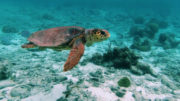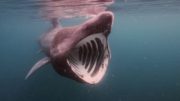Here in Ireland, the programme’s focus is on the beautiful Roseate Tern, one of Europe’s rarest seabirds. The largest European breeding colony is situated on tiny Rockabill Island, off the coast of north Co. Dublin, where a team of wardens from BirdWatch Ireland, led by Dr. Stephen Newton, conserve and monitor the vital population of these very vulnerable birds. Thanks to round-the-clock protection and the provision of special nesting boxes, the Rockabill tern project has gone from strength to strength and is helping to repopulate other parts of Europe with Roseate Terns.
In Northern Ireland we see how natural foes have become unwitting allies, as the dramatic recovery of the predatory Pine Marten is finally changing the fortunes of the threatened Red Squirrel by pushing out the invasive non-native Grey Squirrel, which both outcompetes its native red cousins for food and infects them with disease. In doing so, the Pine Marten is also helping to restore woodland ecosystems which have been damaged by the presence of the Grey Squirrels.
Off the coast of Scotland, we see efforts to tag and track the second-largest fish in the world, the mighty Basking Shark, in the hopes of learning more about their movements and, in particular, their mysterious breeding behaviour. Knowledge is power, and the more that conservationists can learn about these little-known ocean giants, the better they will be able to understand their needs and to help them to survive.
All too often we assume that humans and threatened animals simply cannot coexist, and that increasing urbanisation sadly but unavoidably necessitates the loss of biodiversity. Italian conservationists in Rome would disagree, however, and we focus on the rich wildlife of the Eternal City and show how even the threatened Peregrine Falcon, the fastest animal on the planet, has recovered from near-disastrous population declines to thrive in this busy, bustling city.
A similar thing is happening in The Netherlands, where conservation measures to provide safe city-centre nesting sites for the Common Swift have at long last been helping these amazing migratory birds to live up to their name and once again become common. Masters of flight, they spend more time on the wing than any other creature, only landing each summer to lay their eggs and rear their chicks, then flying non-stop for nine months. They don’t just tolerate urban development, they can thrive in it.
Our cities, too, can and should be havens for bats, as the efforts to protect vulnerable populations of nocturnal Vesper Bats in the town of Bellinzona in Switzerland demonstrate. Long misunderstood and even feared, the local residents have now taken these bats to their hearts. We follow a team of researchers as they develop ways to reduce the impact of human-caused problems such as light pollution on these highly sensitive flying mammals, with remarkable success.
When we think of hamsters, we usually think of the popular furry pets that are so beloved the world over. We can lose sight of the fact that their wild populations are in trouble, however, with numbers of the native European Hamster in particular having suffered terrible declines due to habitat destruction and agricultural intensification. However, conservationists in Bavaria, Germany have been trialling ways to restore the hamsters’ habitats and to ensure that these small, shy rodents can find the food and shelter that they need. They have even developed an innovative way to find these reclusive animals and their hidden breeding burrows, using specially trained hamster-seeking dogs.
It’s not hard to love a hamster, but what if the species that you are trying to save is less charismatic, and spends its existence almost completely out of the public gaze? Europe is home to no fewer than 546 species of freshwater fish, and almost 80% them occur nowhere else on Earth. Nearly half are under grave threat of extinction. A great many of our rivers have been polluted and have had their courses diverted, making it increasingly hard for the fish that live in them to survive. In the picturesque Vipava Valley in Slovenia, fisheries researchers have been restoring the habitat of the localised and endangered South European Nase, and the lessons learned in the quest to save this small fish have applications in other freshwater ecosystems right across Europe.
Climate change is one of the greatest problems facing our world, and it is already posing big challenges for human and animal populations alike. No creatures are set to suffer as much, however, as those that have adapted to live in our planet’s polar regions, where they depend on snow and ice, now rapidly vanishing, for their survival. It’s not all bad news though. In Norway a nationwide project to restore the long-vanished Arctic Fox to many of its former haunts has been bucking the trend, and has been helping to ensure that this small northern predator can have a secure future.
Climate change also threatens the rare Loggerhead Turtle, which has also had to contend with marine pollution and the encroachment of expanding human populations onto its nesting beaches. In Barcelona, Spain conservationists, local communities and municipal authorities have joined forces to help these enchanting oceanic reptiles, with teams of volunteers working to guard their eggs day and night. Even in one of the Mediterranean’s busiest cities, space is being found to accommodate nature, and local people are learning to cherish and celebrate their biodiversity.







